I recently came across an old copy of Bluff your way in the Quantum Universe, a taster/guide that I picked up as a present a few years back and ended up keeping!
Quantum theory is the strangest stuff you've ever heard taken seriously. Its sheer weirdness makes it a favourite part of physics for me, despite the tricky maths that haunted the latter half of my degree.
This very short book serves as a fun introduction. Here's a taster:
"Quantum theory challenges, at the very least, notions of Causality, Predictability, Reversibility, Continuity, Locality, Order, Separateness (sometimes called Isolability), Clear Definition, Accurate and Informative Measurement, Objectivity, Either/or Thinking and, most controversially, Certainty. It threatens notions of solidity and substance, and suggests that there are absolutely no absolutes." (page 28)
It goes on to discuss each of these, but you'll have to borrow the book from me if you want to know what they're all about!
Showing posts with label physics. Show all posts
Showing posts with label physics. Show all posts
Tuesday, May 02, 2006
Thursday, April 06, 2006
The vote is open
I've finally finished selecting my 10 images of space and it's been fantastic to remind myself just how beautiful the universe is.
Some decisions were hard to make.. which nebulae would make it to the final cut?
Here's some images which were near-rejects:
Cygnus loop shockwave
Eskimo Nebula
Spiral galaxies collide
...and many others!
You may disagree with my choices, but all the images I chose have a particular significance.
I'm curious to know which are people's favourites and whether everyone has the same idea of beauty... Let me know your top 3 from the 10 images I've picked.
Some decisions were hard to make.. which nebulae would make it to the final cut?
Here's some images which were near-rejects:
Cygnus loop shockwave
Eskimo Nebula
Spiral galaxies collide
...and many others!
You may disagree with my choices, but all the images I chose have a particular significance.
I'm curious to know which are people's favourites and whether everyone has the same idea of beauty... Let me know your top 3 from the 10 images I've picked.
Tuesday, April 04, 2006
10 beautiful things...
...to see in space!
1. Cat's Eye Nebula
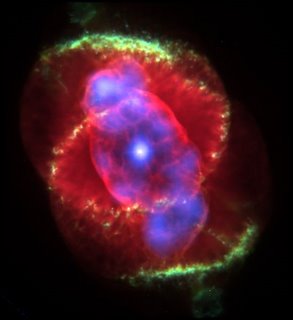
2. Earthrise (taken by Apollo 8) - from NASA Historical Images
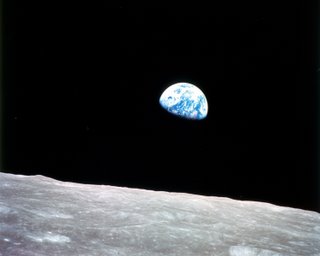
3. Gas pillars in Eagle Nebula (M16)

4. Hubble Ultra Deep Field (HUDP)
This picture looks back in time 13 billion years and despite covering a tiny fraction of the sky (3 arc minutes square) includes 10,000 galaxies! Those points of light? They're not stars...

5. Horsehead Nebula
The dark area that makes up the head is a dark nebula - a thick cloud of hydrogen gas and dust where new stars are being formed. The nebula can be seen here only because it blocks out the light of the emission nebula behind it.

6. Supernova 1994D in Galaxy NGC 4526
Supernovae are massive explosions, often the dying moments of a massive star (although SN 199D is a type 1a supernova, caused by an explosion in a white dwarf star). They shine only briefly but for those few days may outshine the galaxy in which they reside! Supernovae are hugely important 'creation' events, as the force of the explosion forms many of the heavier elements, blasting them into space. (Fusion in stars forms elements up to iron on the Periodic Table, but heavier elements, e.g. copper, tin, silver, gold, are not formed by fusion.)
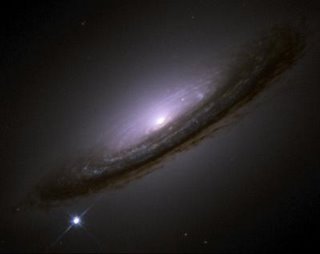
7. Light echo from Red Supergiant V838
This picture is one of a dramatic series of images taken by the Hubble telescope in early 2002 and showing a sudden brightening of star V838 Monocerotis, lighting up the dust clouds around it. It is called a light echo because the pictures show a ring of illumination gradually expanding around the star as the light travels outwards.
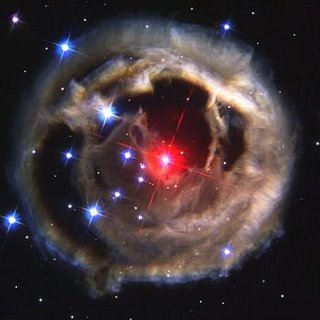
8. ...a picture I would love to take!
Images like this always stump the kids..even when they should know the answer!
I'm sure you'll figure it out straight away.. but can anyone work out the exposure time?

9. The Ring Nebula, in the constellation Lyra
This is one of the most famous Planetary Nebulae, the gas and dust drifting away from the white dwarf (seen in the centre of the image) left behind at the end of a star's life. This is an almost true-colour image, the colours are from the different elements glowing in the dust (blue - hot helium, green - ionized oxygen, red - ionized nitrogen).

10. Twisters in the Lagoon Nebula
The Lagoon Nebula is one of only a few nebulae visible to the naked eye in the Northern Hemisphere and can be seen in the constellation of Sagittarius. Check out the larger picture and explanation.
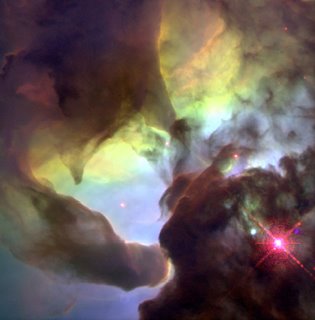
(Note: all these pictures - except the star trails - are from NASA and therefore copyright-free)
1. Cat's Eye Nebula

2. Earthrise (taken by Apollo 8) - from NASA Historical Images

3. Gas pillars in Eagle Nebula (M16)

4. Hubble Ultra Deep Field (HUDP)
This picture looks back in time 13 billion years and despite covering a tiny fraction of the sky (3 arc minutes square) includes 10,000 galaxies! Those points of light? They're not stars...

5. Horsehead Nebula
The dark area that makes up the head is a dark nebula - a thick cloud of hydrogen gas and dust where new stars are being formed. The nebula can be seen here only because it blocks out the light of the emission nebula behind it.

6. Supernova 1994D in Galaxy NGC 4526
Supernovae are massive explosions, often the dying moments of a massive star (although SN 199D is a type 1a supernova, caused by an explosion in a white dwarf star). They shine only briefly but for those few days may outshine the galaxy in which they reside! Supernovae are hugely important 'creation' events, as the force of the explosion forms many of the heavier elements, blasting them into space. (Fusion in stars forms elements up to iron on the Periodic Table, but heavier elements, e.g. copper, tin, silver, gold, are not formed by fusion.)

7. Light echo from Red Supergiant V838
This picture is one of a dramatic series of images taken by the Hubble telescope in early 2002 and showing a sudden brightening of star V838 Monocerotis, lighting up the dust clouds around it. It is called a light echo because the pictures show a ring of illumination gradually expanding around the star as the light travels outwards.

8. ...a picture I would love to take!
Images like this always stump the kids..even when they should know the answer!
I'm sure you'll figure it out straight away.. but can anyone work out the exposure time?

9. The Ring Nebula, in the constellation Lyra
This is one of the most famous Planetary Nebulae, the gas and dust drifting away from the white dwarf (seen in the centre of the image) left behind at the end of a star's life. This is an almost true-colour image, the colours are from the different elements glowing in the dust (blue - hot helium, green - ionized oxygen, red - ionized nitrogen).

10. Twisters in the Lagoon Nebula
The Lagoon Nebula is one of only a few nebulae visible to the naked eye in the Northern Hemisphere and can be seen in the constellation of Sagittarius. Check out the larger picture and explanation.

(Note: all these pictures - except the star trails - are from NASA and therefore copyright-free)
Saturday, November 26, 2005
A non-trivial congruence - or the real beauty of Mathematics
Something I often find myself struggling to explain is the concept of mathematical beauty. It's something that mathematicians and physicists instinctively recognise, but it's not easy to articulate to the lay person!
But I was most heartened to find the following excerpt on John Polkinghorne's website (a wierd site set-up means it's impossible to link straight to the article). He doesn't answer the question of beauty per se but he makes a most appealing case for the amazingness of mathematics generally!
He's discussing aspects of metaphysics... 'aspects of the laws of physics which raise questions beyond physics' competence to answer':
"The first is a property of the physical world that is so familiar to us that we take it for granted. It is, in fact, the necessary basis of the whole scientific endeavor. It is this: that we can understand the world, that it is intelligible to us, that it is rationally transparent. Not only do we understand the world, but it is mathematics which is the key to the understanding of the physical universe. In fundamental physics one looks for theories which in their mathematical expression are economic and elegant, which are mathematically beautiful. Mathematical beauty is a very recognizable characteristic. There is an expectation -- an expectation that has been justified time and again in the history of physics -- that it is just those theories which have the character of mathematical economy and elegance which will prove to be the ones that explain what is going on in the physical world. If you have a friend who is a theoretical physicist, and you wish to upset them, you simply say to them, "That new theory of yours looks rather ugly and contrived to me." They will be truly upset, because you are saying that it does not have the character which successful theory always has had.
When we use mathematics in that way as a heuristic tool, a device for finding out what's going on in the world, something very odd is happening. After all, what is mathematics? Mathematics is the free exploration of the finite human mind. Our mathematical friends sit in their studies and out of their heads they spin the beautiful patterns of mathematics. Mathematics can be thought of as a pattern creating, pattern analyzing, subject. Yet some of the most beautiful patterns that are dreamt up by the pure mathematicians in their studies are found actually to occur in the structures of the physical world around us. In other words, there is a deep-seated congruence between the reason that we experience within (in our minds) and the reason that we experience without (in the physical world around us). They fit together like a glove. That seems a fact about the physical world that is what the mathematicians in their modest way would call non-trivial. 'Non-trivial' is a mathematical word meaning 'highly significant.'"
Wow wow wow (or is it just me?!) I love this guy!
But I was most heartened to find the following excerpt on John Polkinghorne's website (a wierd site set-up means it's impossible to link straight to the article). He doesn't answer the question of beauty per se but he makes a most appealing case for the amazingness of mathematics generally!
He's discussing aspects of metaphysics... 'aspects of the laws of physics which raise questions beyond physics' competence to answer':
"The first is a property of the physical world that is so familiar to us that we take it for granted. It is, in fact, the necessary basis of the whole scientific endeavor. It is this: that we can understand the world, that it is intelligible to us, that it is rationally transparent. Not only do we understand the world, but it is mathematics which is the key to the understanding of the physical universe. In fundamental physics one looks for theories which in their mathematical expression are economic and elegant, which are mathematically beautiful. Mathematical beauty is a very recognizable characteristic. There is an expectation -- an expectation that has been justified time and again in the history of physics -- that it is just those theories which have the character of mathematical economy and elegance which will prove to be the ones that explain what is going on in the physical world. If you have a friend who is a theoretical physicist, and you wish to upset them, you simply say to them, "That new theory of yours looks rather ugly and contrived to me." They will be truly upset, because you are saying that it does not have the character which successful theory always has had.
When we use mathematics in that way as a heuristic tool, a device for finding out what's going on in the world, something very odd is happening. After all, what is mathematics? Mathematics is the free exploration of the finite human mind. Our mathematical friends sit in their studies and out of their heads they spin the beautiful patterns of mathematics. Mathematics can be thought of as a pattern creating, pattern analyzing, subject. Yet some of the most beautiful patterns that are dreamt up by the pure mathematicians in their studies are found actually to occur in the structures of the physical world around us. In other words, there is a deep-seated congruence between the reason that we experience within (in our minds) and the reason that we experience without (in the physical world around us). They fit together like a glove. That seems a fact about the physical world that is what the mathematicians in their modest way would call non-trivial. 'Non-trivial' is a mathematical word meaning 'highly significant.'"
Wow wow wow (or is it just me?!) I love this guy!
Subscribe to:
Posts (Atom)
